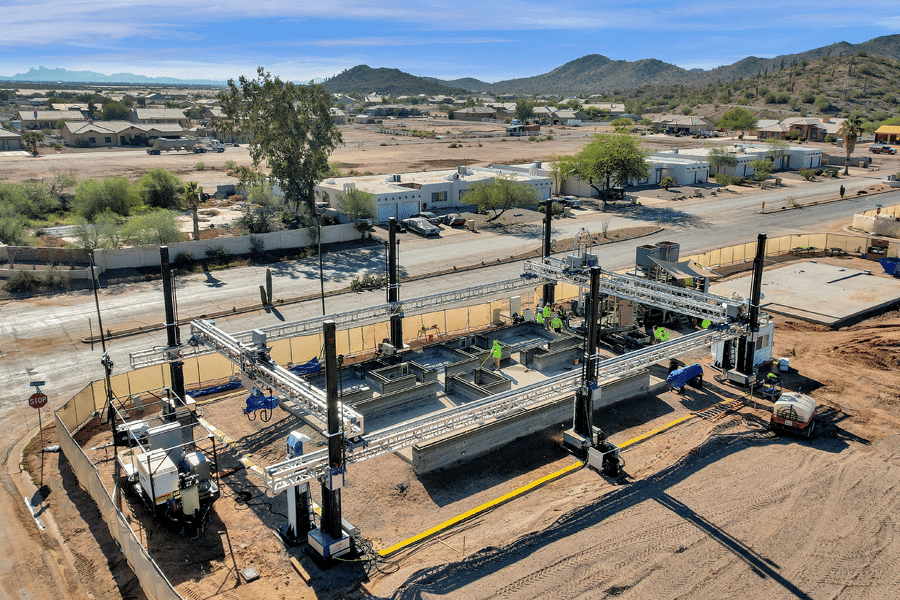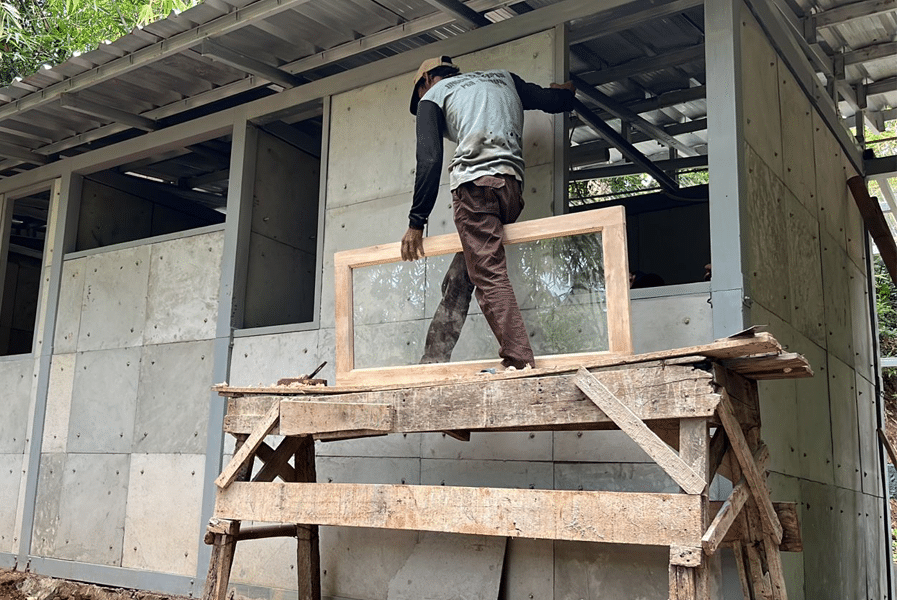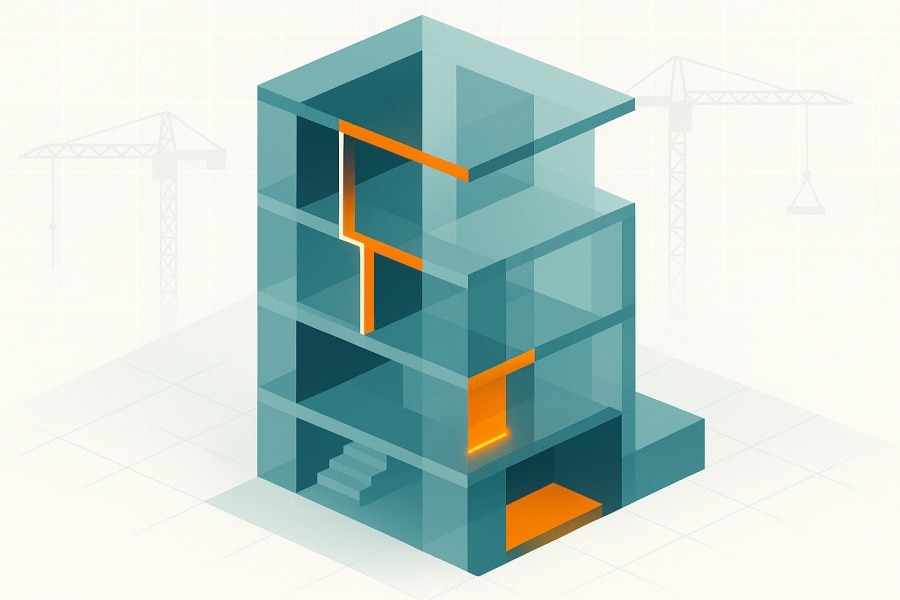Concrete, the No. 1 used material in the world except water, according to the Zurich Polytechnic, is often identified as the most environmentally damaging of construction materials. Or it is a material with amazing properties with uses that might help the construction industry answer the call for more affordable and sustainable dwellings. Or maybe it’s both.
As a building material, concrete is resilient, durable, offers high wind event resistance and is non-combustible. It is used to build everything from homes and apartments to hospitals, schools, bridges and more. But its environmental reputation precedes it: cement, concrete’s main component, is blamed for 8% of the world’s CO₂ emissions—less than 3% of the United States’ CO₂ emissions, according to the Portland Cement Association. Producing one metric ton of cement emits about 1 metric ton of CO₂ into the atmosphere.
Can concrete redeem itself?
A concrete primer
The words “cement” and “concrete” often are used interchangeably, but cement is just one ingredient in concrete, which also includes air, water, sand, gravel and often admixtures.
Cement itself is a combination of chemicals such as calcium, silicon, aluminum and iron and materials such as limestone, which has calcium carbonate and dolomite, shells, chalk and marl, which is composed of minerals, clay and silt.
Curious why 3 million AECO professionals worldwide use Bluebeam to finish projects faster?



The chemicals are heated at roughly 2,700° Fahrenheit to form into marble-sized rock-like substances called “clinker.” This is ground into a fine powder and mixed with gypsum as an additive for controlling the rate of “set time.” The result is cement, and the most widely used type for building is known as Portland Cement, named by its creator in the early 1800s after a stone found on Britain’s Isle of Portland.
Cement is the binder that holds everything together in the concrete. It’s cooking the limestone at high temperatures that releases high amounts of CO₂, which is problematic. What makes concrete so ubiquitous is that it’s readily available and can be manufactured anywhere in the world.
Positives outweigh negatives
Michael Weber, chief operating officer for NileBuilt Corp., builders/developers using a proprietary system technology for building a cementitious, fiber-composite building system for resilient and net zero sustainable homes, has been part of the concrete world for most of his career.
He’s been a voting member on several committees at the American Concrete Institute; has been director of residential, Portland Cement Association; and most recently the national business development manager for the Euclid Chemical Company. In 2006, Weber was named one of the 10 most influential people in the concrete industry by Concrete Construction magazine, and he was the 2019 recipient of NAHB’s Building Systems Councils’ S.A. Walters Lifetime Achievement Award.
When it comes to concrete’s negative environmental effects, Weber said, “Concrete doesn’t get a fair shake when people talk about sustainability. People talk about CO₂ off-gassing from the initial production of the cement for concrete used in a home. But after approximately seven years of running your furnace and A/C system, the CO₂ off-gassing in a wood-based home is generally higher. So, if you want to look at the carbon footprint of a home built with a concrete building system, it is more sustainable than one built with wood.” What’s more, according to Weber, a concrete structure is durable enough to last centuries: See the Egyptian pyramids.
Weber argued that the positives of building with concrete override the negatives. He rattled off a list of benefits:
Non-combustible: “When you reach around 800° Fahrenheit wood combusts, and it doesn’t need embers landing on it to start burning. That doesn’t happen to concrete.” This is especially important, Weber said, because “insurance companies no longer want to insure homes that are combustible.” As the Los Angeles Times reported, Allstate and State Farm announced in mid-2023 that they would not insure any new customers in California, basically because it’s too expensive to rebuild after wildfires.
Energy efficient: The mass of a concrete wall is solid and doesn’t allow areas for air infiltration, providing homeowner comfort from drafts. In some concrete systems, exposing the concrete on the inside provides “thermal mass,” keeping a home’s internal temperature stable. “The internal exposed concrete actually acts like a battery,” Weber explained. “It stores the ambient temperature inside the home and is slow to change from outside temperatures. That’s a huge benefit for energy savings.”
Flood resistant: Since concrete is non-organic, a concrete surface doesn’t promote mold growth and start to rot. “If concrete gets coated with mud from flood waters, it can be cleaned and put back into service,” Weber added.
Provides quiet and comfortable surroundings: The same “mass wall” that keeps the temperature constant keeps out external noise. It also keeps the house from feeling drafty so it’s quiet and comfortable.
Price stable: In some areas, based on the building codes, it’s less expensive to use concrete systems than to build with wood. “Florida is a perfect example,” Weber said. “For many years, the building code requirements in Southern Florida have been designed to meet high wind events like hurricanes, making it more expensive to build with wood than concrete.”
Fast and affordable
Using concrete in US home building is not new. Aside from foundations and basements, Weber said that approximately 14% of homes built in the US annually are built with above-grade concrete walls. Because of new technologies and architectural designs, once the home is built homeowners may not realize it has a concrete wall system.
Concrete’s familiarity has helped Russell Varone, co-founder and chief technology officer at the home constructor Diamond Age and formerly Tesla’s general assembly director, take a chance on concrete.
“If I had come up with a soy-based mushroom foam people would have said, ‘No.’ But they know concrete and I can give them data on compressive strength and shrinkage. It makes stakeholders comfortable,” Varone said.
The Phoenix-based company is automated, but the focus is on robotics, and concrete is the best material for its construction method, similar to 3D printing. Lumber just wouldn’t work. “Concrete is malleable. It’s easy to get and it has an advantage in low-cost homes in that it’s very low maintenance,” Varone said.
The company is working as a “super sub” (engaged in more than three processes) for Century Communities. It is focused on affordable 1,500- to 2,100-square-foot homes to be sold in the $270,000 to $305,000 range. Diamond Age recently finished its 15th home, which takes about two months to complete. Similar lumber-framed homes may take five to nine months to build.
More planet-friendly options
This is not to dismiss concrete’s very real environmental concerns. Varone feels confident that there are enough market forces to drive innovation.
Numerous companies like Solidia, LC3, Brimstone and CarbonCure are attacking the problem from a number of different approaches in the cement and concrete manufacturing process. These include reducing or capturing carbon; lowering the amount of energy used, such as using electricity instead of fossil fuels for heating the cement kilns; integrating recycled aggregates and cementitious materials into the concrete mix; and recycling water when possible. There is also pressure from governments, and climate initiatives abound in US cities and states and around the world. In 2022, Climate Group, in partnership with the World Business Council for Sustainable Development and World Green Building Council, launched the ConcreteZero initiative, with a goal of sourcing 100% net zero concrete by 2050. Seventeen global concrete-consuming businesses signed the pledge.













